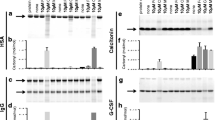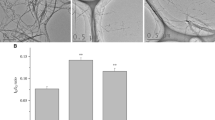Abstract
Purpose. The oxidation of recombinant human interleukin-2 (rhIL-2) by potassium peroxodisulfate (KPS) with or without N,N,N′,N′-tetramethylethylenediamine (TEMED), which are used for the preparation of dextran-based hydrogels, was investigated.
Methods. The oxidation of (derivatives of) methionine, tryptophan, histidine and tyrosine, as well as rhIL-2 was investigated. Both the oxidation kinetics (RP-HPLC) and the nature of the oxidation products (mass spectrometry) were studied as a function of the KPS and TEMED concentration, and the presence of a competitive antioxidant, methionine.
Results. Under conditions relevant for the preparation of rhIL-2 loaded hydrogels, only methionine and tryptophan derivatives were susceptible to oxidation by KPS. The oxidation of these compounds was inhibited once TEMED was present, suggesting that the peroxodisulfate anion, rather than the radicals formed in the presence of TEMED, is the oxidative species. KPS only induced oxidation of the four methionines present in rhIL-2, whereas the tryptophan residue remained unaffected. The radicals, formed after KPS decomposition by TEMED, induced some dimerization of rhIL-2. The oxidation of rhIL-2 could be substantially reduced by the addition of methionine, or by pre-incubation of KPS with TEMED.
Conclusions. Only the methionine residues in rhIL-2 are oxidized by KPS. The extent of oxidation can be minimized by a proper selection of the reaction conditions.
Similar content being viewed by others
REFERENCES
S. A. Rosenberg, M. T. Lotze, L. M. Muul, A. E. Chang, F. P. Avis, S. Leitman, W. M. Linehan, C. N. Robertson, R. E. Lee, and J. T. Rubin. A progress report on the treatment of 157 patients with advanced cancer using lymphokine activated killer cells and interleukin-2 or high-dose interleukin-2 alone. N. Engl. J. Med. 316:889-897 (1987).
W. Den Otter, R. A. Maas, J. W. Koten, H. F. J. Dullens, M. Bernsen, W. R. Klein, V. P. M. G. Rutten, P. A. Steerenberg, L. Balemans, E. J. Ruitenberg, F. W. G. Hill, and P. M. Heintz. Effective immunotherapy with local low doses of interleukin-2. In Vivo 5:561-566 (1991).
W. Den Otter, J. W. de Groot, M. R. Bernsen, P. M. Heintz, R. Maas, G. J. Hordijk, F. W. G. Hill, W. R. Klein, E. J. Ruitenberg, and V. P. M. G. Rutten. Optimal regimes for local IL-2 tumour therapy. Int. J. Cancer 66:400-403 (1996).
J. H. Donohue and S. A. Rosenberg. The fate of interleukin-2 after in vivo administration. J. Immunol. 130:2203-2208 (1983).
N. A. Peppas, P. Bures, W. Leobandung, and H. Ichikawa. Hydrogels in pharmaceutical formulations. Eur. J. Pharm. Biopharm. 50:27-46 (2000).
W. E. Hennink, H. Talsma, J. C. H. Borchert, S. C. de Smedt, and J. Demeester. Controlled release of proteins from dextran hydrogels. J. Control. Release 39:47-55 (1996).
W. N. E. Van Dijk-Wolthuis, J. A. M. Hoogeboom, M. J. van Steenbergen, S. K. Y. Tsang, and W. E. Hennink. Degradation and release behavior of dextran-based hydrogels. Macromolecules 30:4639-4645 (1997).
O. Franssen, L. Vandervennet, P. Roders, and W. E. Hennink. Degradable dextran hydrogels: controlled release of a model protein from cylinders and microspheres. J. Control. Release 60:211-221 (1999).
R. J. H. Stenekes, S. C. de Smedt, J. Demeester, G. Sun, Z. Zhang, and W. E. Hennink. Pore sizes in hydrated dextran microspheres. Biomacromolecules 1:696-703 (2001).
S. Li, C. Schöneich and R. T. Borchardt. Chemical instability of protein pharmaceuticals: mechanisms of oxidation and strategies for stabilization. Biotechnol. Bioeng. 48:490-500 (1995).
N. Brot and H. Weissbach. Biochemistry and physiological role of methionine sulfoxide residues in proteins. Arch. Biochem. Biophys. 223:271-281 (1983).
R. J. H. Stenekes and W. E. Hennink. Polymerization kinetics of dextran-bound methacrylate in an aqueous two phase system. Polymer 41:5563-5569 (2000).
K. Sasaoki, T. Hiroshima, S. Kusumoto, and K. Nishi. Oxidation of methionine residues of recombinant human interleukin-2 in aqueous solutions. Chem. Pharm. Bull. 37:2160-2164 (1989).
E. Atherton and R. C. Sheppard. Solid Phase Peptide Synthesis, IRL Press, Oxford, England, 1989.
G. B. Fields and R. L. Noble. Solid-phase peptide synthesis utilizing 9-fluorenylmethoxycarbonyl amino acids. Int. J. Pept. Protein Res. 35:161-214 (1990).
F. J. Koppenhagen, G. Storm, and W. J. Underberg. Development of a routine analysis method for liposome encapsulated recombinant interleukin-2. J. Chromatogr. B. Biomed. Sci. Appl. 716:285-291 (1998).
T. H. Nguyen, J. Burnier, and W. Meng. The kinetics of relaxin oxidation by hydrogen peroxide. Pharm. Res. 10:1563-1571 (1993).
W. Wang. Instability, stabilization, and formulation of liquid protein pharmaceuticals. Int. J. Pharm. 185:129-188 (1999).
G. Kell and H. Steinhart. Oxidation of tryptophan by H2O2 in model systems. J. Food Sci. 55:1120-1123 (1990).
R. C. Weast. Handbook of Chemistry and Physics, 62nd edition, CRC Press, Florida (1981–1982).
X. L. Lam, J. Y. Yang, and J. L. Cleland. Antioxidants for prevention of methionine oxidation in recombinant monoclonal antibody HER2. J. Pharm. Sci. 86:1250-1255 (1997).
X. De Feng, X. Qiu Guo, and K. Yuan Qiu. Study on the initiation mechanism of the vinyl polymerization with the system persulfate/N,N,N′,N′-tetramethylethylene diamine. Makromol. Chem. 189:77-83 (1988).
F. J. Koppenhagen, A. J. W. G. Visser, J. N. Herron, G. Storm, and D. J. A. Crommelin. Interaction of recombinant interleukin-2 with liposomal bilayers. J. Pharm. Sci. 87:707-714 (1998).
D. Perrin and W. H. Koppenol. The quantitative oxidation of methionine to methionine sulfoxide by peroxonitrite. Arch. Biochem. Biophys. 377:266-272 (2000).
N. Brot and H. Weissbach. The biochemistry of methionine sulfoxide residues in proteins. Trends Biochem. Sci. 7:137-139 (1982).
R. T. Dean, S. Fu, R. Stocker, and M. J. Davies. Biochemistry and pathology of radical-mediated protein oxidation. Biochem. J. 324:1-18 (1997).
Author information
Authors and Affiliations
Rights and permissions
About this article
Cite this article
Cadée, J.A., van Steenbergen, M.J., Versluis, C. et al. Oxidation of Recombinant Human Interleukin-2 by Potassium Peroxodisulfate. Pharm Res 18, 1461–1467 (2001). https://doi.org/10.1023/A:1012213108319
Issue Date:
DOI: https://doi.org/10.1023/A:1012213108319




